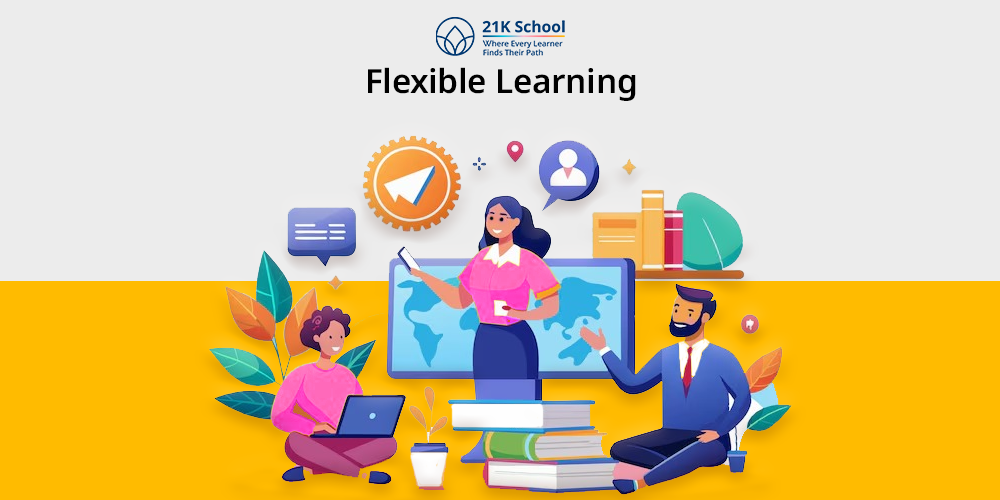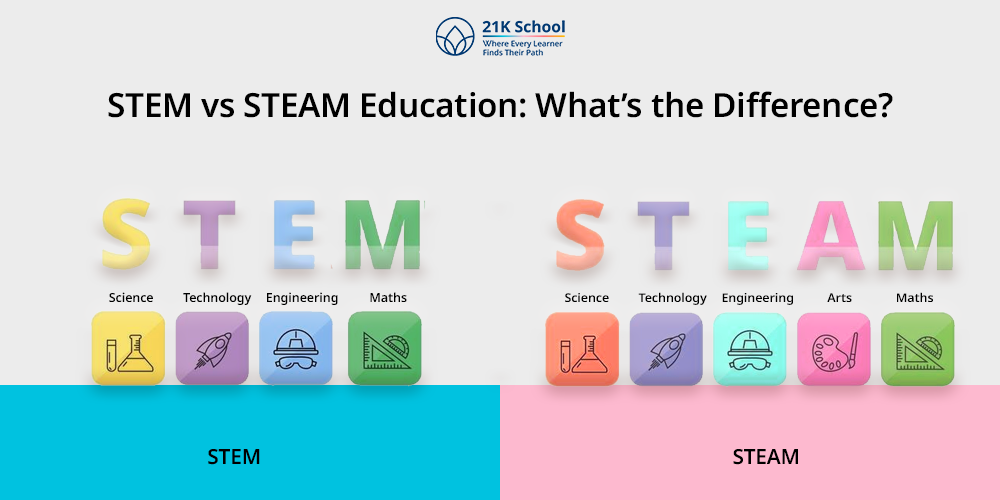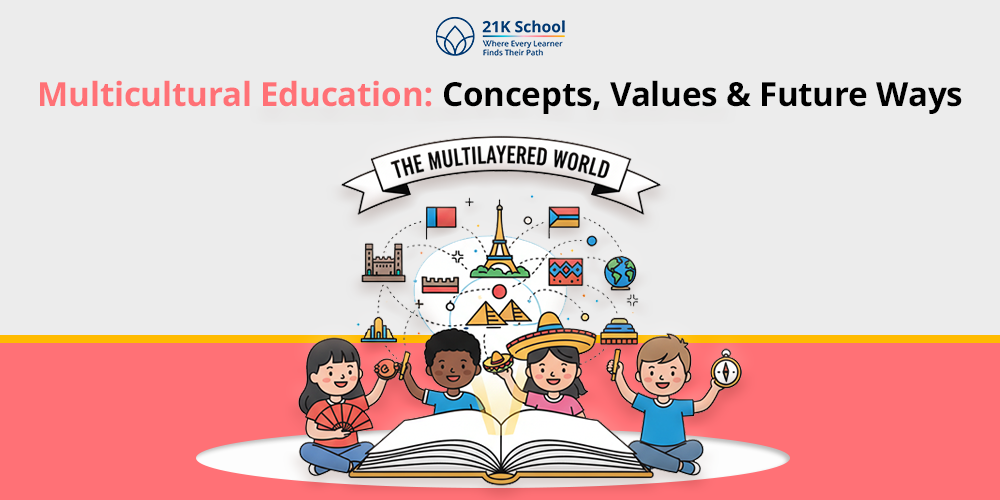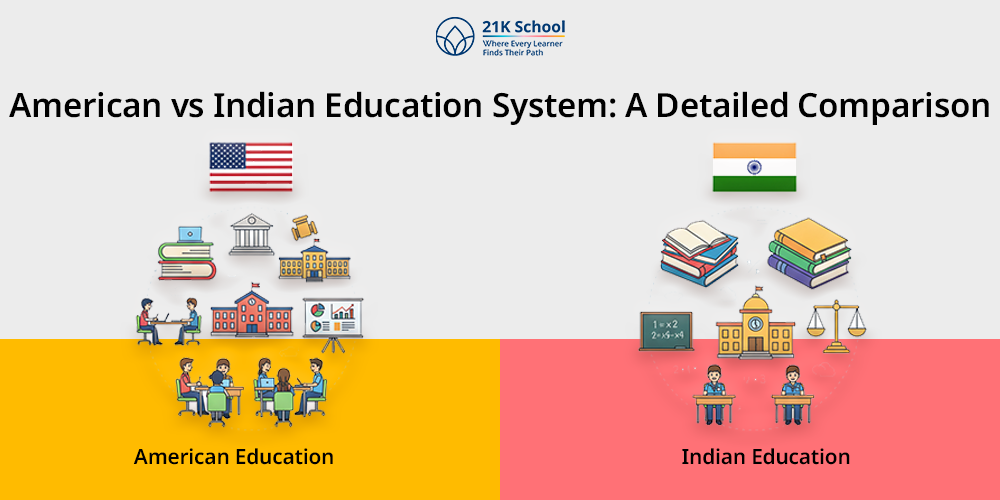
Have you ever wondered how education can be made more flexible?
Flexible learning is an educational approach that provides students with autonomy. Flexible learning provides adaptability and enables students to study at their own pace and learning style.
This method of learning emphasises personalised learning and enables students to study through customised education. Every student has their own learning style and capacity for grasping knowledge.
Flexible learning basically denotes open and distance education , in which students can study as per their convenience.
The method of flexible learning mostly provides students with educational resources that are flexible, which provides equal accessibility of education to students.
This learning method promotes an inclusive learning environment enabling students of different backgrounds to study equally without any challenges. It promotes diversity in program design and instructional delivery methods.
Contents
- 1 What is Flexible Learning?
- 2 Key 5 Features of Flexible Learning
- 3 5 Importance of Flexible learning
- 4 8 Benefits of Flexible Learning
- 5 5 Drawbacks of Flexible Learning
- 6 5 Flexible Learning Examples
- 7 How to Integrate Flexible Learning
- 8 6 Tools Used to Implement Flexible Learning
- 9 Flexible Learning Pathways
- 10 Wrapping Up
What is Flexible Learning?
Flexible learning is an educational approach that provides students with the freedom to study whenever they want. Through flexible learning, students can decide what, when, how and where to study, which enhances students’ ability to grasp knowledge more effectively.
Every student has their own learning style and capacity to gain knowledge, and personalised education enables them to study as per their own comfort level. Flexible learning is also known for enhancing communication skills and collaboration skills among students.
As compared to traditional education , which has a fixed and structured study schedule, flexible learning offers an adapted study routine to students and enables students to study from their own home or any location.
The contribution of technology has made flexible learning more accessible, through which students can attend classes with the help of e-learning platforms .
Key 5 Features of Flexible Learning
Flexible learning plays an essential role in the holistic development of children through holistic education . The flexibility allows childrens to study at their own speed and accuracy, which enhances their problem-solving skills .
With the help of flexible learning, students can study from any location, irrespective of any challenges, as studying at home also helps in enhancing collaboration skills.
With the help of the internet, students can connect with each other from any location, even internationally. The following are the key features of flexible learning.
1. Self-Paced Learning
Flexible learning helps in promoting self-paced learning, which allows students to proceed with their studies at their own pace which accommodates a variety of learning styles.
Students are free to take as much time as needed to understand concepts because there is no time limit.
Students benefit from this flexibility since it allows them to take the necessary time to fully comprehend the material, which reduces study stress and enhances comprehension.
2. Learner-Centred Approach
Flexible learning is a student-centered learning approach which provides autonomy to students in which they have control over their studies.
This approach of education allows students to indulge in self-directed learning and are urged to actively participate in their education, set personal goals and choose their own learning paths.
Students are more motivated and feel more accountable because they are more involved in their education.
3. ICT in Education
Flexible learning integrates Information and Communication Technology (ICT). ICT in education combines digital resources, educational softwares and virtual learning platforms to provide students with a wealth of information and collaborative learning environment.
This technology supports multiple learning approaches, facilitates real-time feedback and assessment as well as enhances teacher-student relationships .
4. Customised Learning
Flexible learning opportunities create customised learning experiences for students. Customised lessons help in providing tailored educational needs, which allows students to study as per their own convenience.
Customised learning enhances learning outcomes by allowing each student to engage with the material in a way that suits them best.
5. Flexible Learning Choice
Flexible learning choice allows students to choose between online, blended or traditional classroom learning methods. Students can manage their academic goals with their personal and professional responsibilities by having choices about when and where to learn.
This option increases student satisfaction and success by empowering them to take control of their education.
5 Importance of Flexible learning
Flexible learning plays an integral role in education, which makes learning more adaptable and customised. Every student has their own learning pace, and this flexibility allows students to study as per their own convenience.
Flexible education provides educational equity , removes the barriers of education and promotes an inclusive learning environment. The following are the importance of flexible learning.
1. Freedom of Study
Flexible learning gives students the flexibility to choose how, when, and where to study. The ability to adapt to their own schedules and learning styles allows students to customise their educational experiences.
Students can select courses that align with their interests and career goals, work through the material at their own pace and utilise a range of resources that best suit their preferred learning styles.
2. Balanced Study
Flexible learning allows students to balance their academic responsibilities with other aspects of their lives, such as their jobs, families and hobbies.
Allowing students to schedule their own study sessions helps them fit study time into their schedules, which reduces student stress and anxiety. The ability to balance multiple responsibilities is especially beneficial for working individuals.
3. Equal Accessibility
Flexible learning provides all students with equal access to education regardless of their backgrounds, financial status or physical capabilities.
Online courses and digital resources can reach people who are unable to attend traditional schooling due to health or mobility issues or who live in remote areas.
This inclusivity promotes social equity by ensuring that a wider range of students can obtain high-quality education and closing educational gaps.
4. Promotes Global Collaboration
Flexible learning promotes global collaboration with the help of technology. Through technology such as e-learning platforms or digital classrooms , students can connect with anyone internationally.
Through this, students can engage in international discussions with classmates from different backgrounds and work on online group projects . These interactions help students learn more academically and get ready for a workforce that is increasingly globalised.
5. Promotes an Inclusive Learning Environment
Flexible learning promotes inclusive learning environments through an inclusive classroom that caters to the needs of diverse learners.
Teachers can provide a range of formats such as hybrid models, online courses and personalised learning paths to accommodate a variety of learning preferences and styles.
This inclusivity will give every student, including those with special learning needs or disabilities, the opportunity to succeed.
8 Benefits of Flexible Learning
Flexible learning provides students with the freedom to choose their study techniques and strategies. The flexibility allows students to become more determined and better understand their performance.
Through flexible learning, students can study at any location irrespective of any challenges, through providing proper support and guidance.
This flexible approach to education also enhances students’ mental health and reduces exam stress. The benefits of flexible learning are mentioned below.
1. Accessibility
Flexible learning provides students with equal access to learning materials virtually from any location with an internet connection. This learning and teaching method eliminates the geographical barriers, allowing people to study at home or during breaks.
Flexible learning programs offer asynchronous learning , which lets students review and complete assignments at their own pace, especially for students with busy schedules.
2. Personalised Learning
Flexible learning from previous students with a personalised learning experience. This approach tailors the educational process to the unique needs and preferences of each student.
Students can concentrate more on challenging material and move through easier sections more quickly when they are allowed to progress at their own pace. This personalisation increases the effectiveness and efficiency of education by improving comprehension and knowledge retention for students.
3. Lifelong Learning
Flexible learning encourages students to continue learning new things throughout their lives, which promotes lifelong learning .
Given the rapidly evolving nature of the labour market and the frequent need for continuous education to stay updated with emerging methods and technologies, this adaptability is crucial. Flexible learning promotes self-directed learning opportunities, enabling students to study on their own and indulge in lifelong education.
4. Student Engagement and Motivation
Flexible learning allows students to choose how and when they learn usually results in higher levels of motivation and engagement.
Students experience greater control over their educational journeys as a result of this autonomy, which raises the importance and relevance of learning to their personal and professional lives.
5. Student-Centred Approach
Flexible learning focuses on a student-centred approach by concentrating on the needs, interests and goals of the learner.
With this approach, which encourages active engagement and teamwork, students can take charge of their educational journeys and develop their creative thinking skills as well as problem-solving skills. Student-centred approach makes learning adaptable and students take charge of their education, which also enhances their love for learning.
6. Adaptable
Educational programs can be adaptable to accommodate students’ diverse commitments and lifestyles due to the adaptability of flexible learning.
Students can adjust their study strategies and plans without sacrificing their academic goals to accommodate their family, jobs and other commitments with this flexibility. This adaptability makes learning more flexible and comfortable, which enhances their creative thinking skills .
7. Time Management
Flexible Learning also enhances time management skills among students. Through proper time management skills , students learn to balance their academic commitments with other responsibilities in their lives they become more adaptable at time management.
Task prioritisation and schedules assist students in effectively managing their time, which increases productivity and reduces stress.
8. Enhanced Learning Effectiveness
Personalised learning paths and self-paced study significantly improve learning efficacy. Students who engage with the material in ways that fit their preferred learning styles have higher retention and comprehension rates.
In addition to increasing academic performance, this specialised approach helps students to indulge in self-regulated learning that prepares them for challenges they may encounter in the real world.
5 Drawbacks of Flexible Learning
Flexible learning offers educational freedom and self-paced learning opportunities, through which students can also focus on different objectives.
However, along with so many advantages, flexible learning has lots of drawbacks, which create hindrances for students. These drawbacks create problems for students’ learning ability and hamper their learning style. Here are the mentioned drawbacks of flexible learning.
1. Isolation
In flexible learning environments, students may experience feelings of isolation due to the lack of in-person interactions. This lack of social interaction can hamper students’ motivation and hamper their critical thinking skills.
Flexible learning sometimes hampers collaboration skills that are offered in traditional classrooms, which may impact their overall educational experience.
2. Technical Dependence
Flexible learning relies heavily on technology, which can be problematic if students lack access to reliable devices or internet connections. Students may find it challenging to fully participate in class due to technical difficulties that disrupt instruction.
Internet issues, software glitches, device malfunctions, etc., also hamper the learning process, which hampers students’ ability to learn to their full potential.
3. Lack of Motivation
Lack of motivation is a major cause of flexible learning. In a flexible learning method, there is no structured classroom, which can be hard for students to stay motivated.
Without external supervision, it can be difficult for students to take greater responsibility for their education. Due to a lack of motivation, many students easily become distracted, which affects their academic performance and level of involvement.
4. Digital Divide
The digital divide is another major cause for flexible learning. Students from lower socioeconomic backgrounds who lack access to computers and reliable internet may find it difficult to participate in online courses.
The ability of students to engage in flexible learning could be significantly impacted by this disparity. This hampers students’ ability to grasp information or study at their own homes.
5. Improper Assessment
Assessing student learning is especially challenging in a flexible learning environment. In an online context, traditional assessment methods might not accurately reflect students’ knowledge and skills.
Due to improper assessment, there might be more opportunities for cheating when there is no in-person supervision, which creates problems with academic integrity.
Also Read, Difference between flexible learning and blended learning .
5 Flexible Learning Examples
Flexible learning includes a variety of learning styles, which enables students to study as per their comfortability. Flexible learning uses digital mode, traditional mode or sometimes blended mode to teach students with the content.
Flexible learning examples basically contain the mode of the teaching and learning process majorly in online resources. Here are some examples of flexible learning.
1. Face-to-Face Communication
Flexible learning also combines face-to-face communication in the form of a blended and flipped classroom model . With this conventional approach students and teachers engage directly in a classroom environment.
It makes it possible for personal interaction, quick feedback and the growth of interpersonal abilities. Group discussions, workshops and practical exercises can improve face-to-face communication, making it an engaging method of instruction.
2. Digital Communication
Digital communication includes many online learning tools and platforms. Digital communication includes asynchronous learning, which entails Emails, discussion boards and social media groups, which enhances communication between students and teachers.
Students can interact with peers and content at their convenience with the help of digital communications.
3. Chatrooms
Chatrooms are an effective example of flexible learning. Chat Rooms allow teachers and students to collaborate and communicate in real time. They are useful for group discussions and Q&A sessions in study groups.
This method fosters a sense of community and allows for immediate communication which makes it easier for students to ask for help and share ideas. Chat Rooms can be particularly useful for distance learning .
4. Pre-recorded Videos
Pre-recorded videos are a common flexible learning tool that allows students to access lectures and instructional materials at their own pace.
These videos can be watched anytime, anywhere, to accommodate different learning styles and speeds. They can also include interactive elements such as tests or discussion starters to increase involvement.
5. Personal Tutoring
Personal tutoring offers individualised support to meet each student’s specific needs and learning goals.
Through personalised guidance and feedback, this one-on-one approach helps students overcome challenges and develop a deeper understanding of the material. Personal tutoring can be done in person or online and offers flexibility with regard to time and place.
How to Integrate Flexible Learning
Flexible learning can be integrated through various strategies and learning methods. This learning method promotes a flexible, equal, accessible and simpler model of education to students from any background, irrespective of any challenges.
This flexibility allows students to study at their own pace with their learning style and objectives. This method combines elements of online learning material with a flexible approach. Here are the ways through which flexible learning can be integrated.
1. Blended Learning
Blended learning combines both the aspects of online learning with traditional in-person instruction. This method allows students to be involved in face to face interactions with teachers and access digital resources at their own pace using this method.
This model encourages flexibility since students can choose when and where to engage with online resources while still receiving the advantages of a physical classroom.
2. Micro Learning
Microlearning is another method to implement flexible learning. Through microlearning students can break down complex or big topics into small digestible chunks. This allows students to grasp information more quickly and make it easier for them to memorise big contents.
This approach allows students to engage with the material for a short period. Students can learn at their own pace and review content as needed when challenging subjects are broken down into digestible lessons.
3. Flipped Classroom
Another way to integrate flexible learning is to combine flipped classrooms. The flipped classroom model flips the traditional learning structures.
With this method students study with the material outside of the classroom before using class time for interactive exercises, discussions and project work. Teachers can provide personalised education in the classroom and encourage active learning with a flipped learning solution .
4. Distance Learning
In distance learning, educational programs are regularly delivered remotely through online platforms. The flexibility of this method helps students who may not be able to attend traditional classes due to personal or geographic constraints.
This flexible learning approach allows students to study from any location, irrespective of any challenges or hindrances.
5. Inclusive Learning
Inclusive learning method is an incredible way to promote flexible learning. Inclusive learning seeks to create an equitable learning environment in order to address the various needs of every student, including those with disabilities or learning differences.
All students can access the curriculum through a variety of engagement, representation and expression methods that educators can offer by implementing flexible learning strategies.
6 Tools Used to Implement Flexible Learning
Flexible learning can be implemented through various digital tools and platforms. The digital resources and the contribution of technology in education makes learning more flexible and adaptable.
This tool allows students to study as per their convenience and makes learning more accessible to every student. These tools include LMS, audio visual elements, animation, online classes, digital libraries, etc.
These elements make learning easy and interactive which also enhances student engagement. Here are the tools that are mostly used to implement flexible learning.
1. LMS
Learning Management System (LMS) is a software platform that facilitates the administration of training programs or courses, record monitoring and reporting.
It helps educators to create and manage teaching materials, track students progress and provide personalised education according to each student’s needs. LMS is an effective tool used to implement flexible learning in a class environment.
2. Audio/Video Conferencing
Audio and video conferencing are an incredible way to implement flexible learning. Technology in education combines real-time audio and video communication between educators and learners, enhancing students’ learning ability.
These tools improve the efficiency and engagement of remote learning by enabling real-time discussions, presentations and group activities. Thus, the method makes learning more engaging and impactful, allowing children to actively participate in the classroom.
3. Multimedia System
Multimedia systems create a positive learning environment by combining various content formats, including text, audio, video, animation and graphics.
This method enhances memory retention and accommodates various learning styles by offering multiple ways to interact with the content. This flexible learning method makes education a fun learning approach, which also focuses on promoting dynamic education .
4. MOOC
Massive Open Online Courses (MOOC) are a type of online course usually offered for free or at a reduced cost that can accommodate a large number of participants.
Through the flexible learning options provided by MOOCs, students can access excellent teaching resources from anywhere in the world. They usually consist of video lectures and discussion board quizzes. In this method, the students can learn through open sources such as Facebook.
5. Online Classes
Online classes, which are also known as e-classes or digital classes, are organised classes conducted through virtual learning platforms that allow students to participate remotely.
These classes provide scheduling, flexibility and access to a wide range of subjects, with the use of recorded sessions, live lectures and interactive exercises. This learning approach is extremely flexible and allows students to study from any location.
6. E-Resources
E-resources are the digital resources that support education through e-books, articles, videos and interactive content. E-resources allow students to increase their understanding and engagement with the content because they are accessible from any location at any time.
Through e-resources, students don’t have to spend any money on physical books or notes; instead, they can download them in PDF format.
Flexible Learning Pathways
Flexible learning pathways are an educational system that makes education flexible and personalised to students. Flexible learning pathways are instructional strategies that offer students a range of options for where, when and how they learn.
By addressing a variety of needs and preferences, these learning pathways aim to increase student autonomy and customise the educational experience. The flexible learning pathways are provided by various online schools, such as 21K School and universities, which allow students to receive tailored learning.
Online blended learning experiences are often combined with open educational resources and technology. The flexibility of education makes learning more engaging through combining various content, such as multimedia, animation, graphics, web learning, etc.
Students who have quality access to flexible learning pathways can always align their academic objectives with their university career with the assistance of their teachers.
Wrapping Up
Flexible learning offers a vibrant student-centred approach that meets the diverse needs of students. By incorporating technology that promotes independence and allows for self-paced learning, it allows students to personalise their educational experiences.
It promotes inclusivity, accessibility and global collaboration, but it also has disadvantages like low motivation, loneliness and technical issues.
Despite these drawbacks, the flexibility offered by this learning model can significantly raise student engagement, promote lifelong learning and equip students with the skills they need to thrive in the contemporary world.
If given the right resources and support, flexible learning has the potential to completely transform education and make it more inclusive, adaptable and successful for all students.



